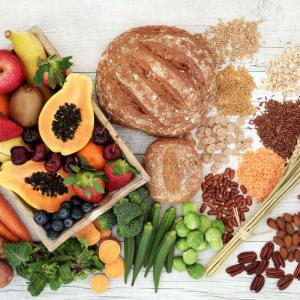In the long term, however, fructose consumed in large quantities favors the accumulation of excess pounds with the appearance of abdominal obesity, so the moderate use of crystallized fructose sweeteners and corn syrup is recommended.
Similar to glucose, fructose is a monosaccharide found in fruits (apples, figs, dates, pears, plums) and certain vegetables (asparagus, mushrooms, onions, bell peppers) together with other sugars, with which it binds and forms sucrose.
Artificial fructose in crystallized form added to various preparations and drinks is obtained from corn or after processing sucrose.
What are the differences between fructose naturally present in fruits and that in processed products?
Natural monosaccharides are present in fruits and vegetables and differ from artificial sweeteners obtained through chemical processing in the food industry . Fructose is found in fruits along with other essential nutrients represented by vitamins, minerals and dietary fibers, whose role is to slow down the breakdown and absorption of the monosaccharide in the digestive tract, preventing the sudden increase in the glycemic level.
After ingestion, the artificial fructose obtained in the laboratory is quickly used by the body in order to obtain energy, the surplus being stored in the liver in the form of fat (fatty liver) . Blood sugar drops rapidly after the ingestion of artificial fructose and generates a feeling of intense hunger, irritability and the imperative need to eat, aspects that favor the accumulation of excess pounds with the appearance of abdominal obesity.
Another consequence of the ingestion of artificial sugar is the disruption of the microbiome, especially of the intestinal microbiome that ensures the proper functioning of the body's defense system. The beneficial bacteria that make up the intestinal flora modulate the ability to defend against infections, prevent the appearance of allergies and immune-type inflammatory diseases, while ensuring good functioning of the intestinal transit.
The beneficial effects represented by the reduced calorie content of artificial sugar are exceeded in the long term by the increased risk of obesity and secondary cardiovascular diseases , so it is recommended to consume fructose obtained through chemical processing in moderation.
The main food sources of artificial fructose are represented by:
- Carbonated drinks
- Sports drinks
- Non-carbonated soft drinks based on tea, with fruit flavors
- Fruit yogurts
- Cake
- Pastry products
- Paine
- Ice cream
- Ready-made salad dressings
- Sweetened cereals eaten for breakfast.
What are the fruits with a high glucose content?
Glucose is an indispensable element for the development of physiological metabolic processes and the obtaining of energy necessary for the good functioning of the body. It is recommended that the majority of its intake be ensured by the consumption of fresh fruits and vegetables and less processed sweets. Fruits with a high glucose content are:
- Dried figs
- Watermelon
- Pineapple
- Grapes.
What are the fruits with a low glucose content?
Most fruits have a low or medium glycemic index . Compared to other carbohydrates, such as white bread or potatoes, they cause a moderate increase in blood sugar. However, diabetic people are advised by the nutritionist to mainly consume fruits with low glucose intake, such as:
- Worry
- Lemon
- Lime
- Grapefruit
- Oranges
- Avocado
- Peaches.
The current nutrition guidelines recommend diabetics to consume moderate daily fresh fruit divided into 1-2 portions.
It should be mentioned that dried fruits and canned fruits or compotes contain more sugars than those in a fresh state, so it is recommended to avoid them by people with diabetes or people who want to limit the intake of sugars to lose extra pounds.
What are the effects of excessive glucose consumption?
The main unwanted effect of the excessive consumption of glucose resulting from the ingestion of carbohydrates in increased quantities is represented by the appearance of cell resistance to the effect of insulin synthesized in the pancreas. Insulin is the hormone that ensures the use of glucose at the cellular level as the body's main source of energy.
Insulin resistance increases the risk of:
- Metabolic syndrome
- Obesity
- Cardiovascular pathologies
- Type II diabetes.
On the other hand, the consumption of increased amounts of glucose favors the increase in appetite and the ingestion of larger amounts of food than are necessary for the body. This surplus of caloric intake determines the growth of the adipose layer with the appearance of extra pounds and the risk of developing cardiovascular and metabolic pathologies.
Sugar addiction is explained by the ability of sugars to stimulate the synthesis and release of dopamine, also known as the hormone of happiness. The well-being associated with the consumption of drinks and foods sweetened with artificial sugars favors the establishment of nutritional imbalances with the appearance of excess weight, metabolic and cardiovascular pathologies.
How do we evaluate the consumption of sugars?
The glycemic index is a method of evaluating the effect that food sugar has on blood sugar. Fructose has a lower glycemic index than sucrose (ordinary table sugar).
Foods with a glycemic index of less than 55 are recommended for diabetics because they help keep blood sugar under control.
Fructose has a glycemic index of approximately 20 compared to sucrose which can sometimes reach a value of almost 65. This characteristic of fructose is the main reason why the monosaccharide is frequently used in commerce to sweeten drinks and foods to the detriment of sucrose.
WHO recommendations regarding the consumption of sugars
The latest research conducted at the global level attests to the fact that approximately 49% of the adult population and 63% of the pediatric population consume sweetened beverages daily. The sugar from these is metabolized differently by the body compared to that from solid food. Sugars from commercial juices are quickly stored in the liver, which considerably increases the risk of obesity and hepatic steatosis.
According to the latest recommendations of the World Health Organization, sugar consumption should be limited to 5% (approximately 25 grams / 0.9oz) of the daily diet of a normal-weight individual. The American Heart Association issued a recommendation regarding the daily consumption of sugars, which specifies that women should limit their consumption to less than 25 grams (0.9oz) of sugar (6 teaspoons), and men to less than 36 grams (1.3oz) (9 teaspoons).
The recommendations issued by the WHO refer mainly to the intake of free sugars from processed foods and those added by the consumer to the food, and include glucose, fructose and table sugar . Along with these, the sugars found in honey, syrups, fruit juices and fruit concentrates are also included. However, the WHO recommendations regarding the reduction of sugar consumption do NOT refer to the sugar contained naturally in fresh fruits and vegetables, which must not be missing from a balanced daily diet.







